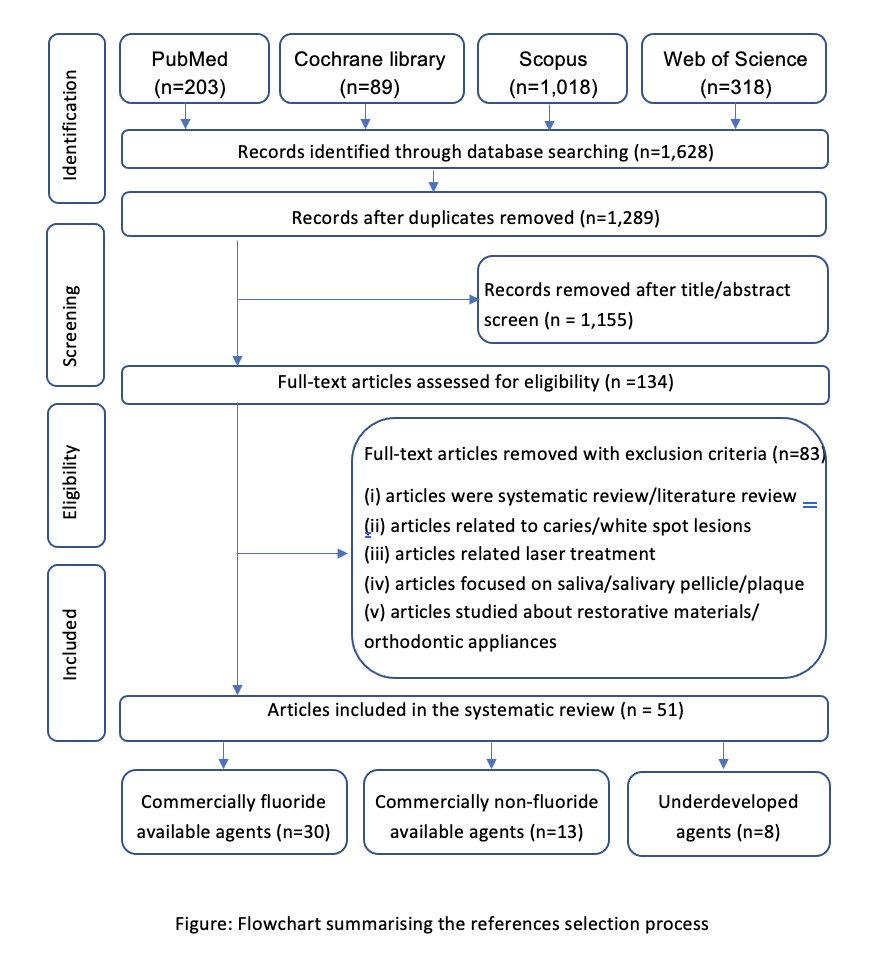IADR Abstract Archives
A Systematic Review of Topical Anti-Erosive Agents on Dental Erosion
Objectives: To provide an overview of anti-erosive agents for non-operative management of dental erosion.
Methods: The literature search was conducted on four databases: PubMed, Cochrane Library, Scopus, and Web of Science.
The keywords of the search were ("Dental erosion" OR "Tooth erosion" OR "Enamel erosion" OR "Dentine erosion" OR "Eroded" OR "Erosive lesion" OR "Erosive demineralization*") AND ("Prevention" OR "Protection" OR "Protective effect*" OR "Anti-erosion" OR "Anti-erosive”)
The inclusion criteria were (i) in situ and clinical studies examined on topical anti-erosive application, (ii) articles published between the year 2010-2021.
The exclusion criteria were (i) articles related to caries/white spot lesion, (ii) articles related to laser treatment, (iii) articles focused on saliva/salivary pellicle/plaque, (iv) articles studied about restorative materials/orthodontic appliances.
Results: 51 articles were included for the analysis. The results showed 15 anti-erosive agents were used for the non-operative management of dental erosion, including commercially available agents and those still under development. Commercially available anti-erosive agents use fluoride, mineral-based materials, or biopolymers as active ingredients. Fluoride agents promote remineralization, but their effect on the management of dental erosion was inconclusive in the literature. Anti-erosive agents contain mineral-based materials that provide additional mineral ions to promote remineralization. Another type of agent used biopolymers as active ingredients. Because of the limited anti-erosive effects of these commercially available products, new agents with anti-erosive properties are under development, including titanium tetrafluoride, sodium trimetaphosphate, sodium hexametaphosphate, linear sodium polyphosphate, epigallocatechin gallate, polymethylvinylether-maleic anhydride, and carbopol.
Conclusions: Anti-erosive agents were available for the non-operative management of dental erosion. These agents generally process good potential to prevent dental erosion. However, current evidence showed inconsistent or limited results to support the use of these agents in clinical settings. Therefore, more clinical studies are essential to demonstrate their success in the management of dental erosion.
Methods: The literature search was conducted on four databases: PubMed, Cochrane Library, Scopus, and Web of Science.
The keywords of the search were ("Dental erosion" OR "Tooth erosion" OR "Enamel erosion" OR "Dentine erosion" OR "Eroded" OR "Erosive lesion" OR "Erosive demineralization*") AND ("Prevention" OR "Protection" OR "Protective effect*" OR "Anti-erosion" OR "Anti-erosive”)
The inclusion criteria were (i) in situ and clinical studies examined on topical anti-erosive application, (ii) articles published between the year 2010-2021.
The exclusion criteria were (i) articles related to caries/white spot lesion, (ii) articles related to laser treatment, (iii) articles focused on saliva/salivary pellicle/plaque, (iv) articles studied about restorative materials/orthodontic appliances.
Results: 51 articles were included for the analysis. The results showed 15 anti-erosive agents were used for the non-operative management of dental erosion, including commercially available agents and those still under development. Commercially available anti-erosive agents use fluoride, mineral-based materials, or biopolymers as active ingredients. Fluoride agents promote remineralization, but their effect on the management of dental erosion was inconclusive in the literature. Anti-erosive agents contain mineral-based materials that provide additional mineral ions to promote remineralization. Another type of agent used biopolymers as active ingredients. Because of the limited anti-erosive effects of these commercially available products, new agents with anti-erosive properties are under development, including titanium tetrafluoride, sodium trimetaphosphate, sodium hexametaphosphate, linear sodium polyphosphate, epigallocatechin gallate, polymethylvinylether-maleic anhydride, and carbopol.
Conclusions: Anti-erosive agents were available for the non-operative management of dental erosion. These agents generally process good potential to prevent dental erosion. However, current evidence showed inconsistent or limited results to support the use of these agents in clinical settings. Therefore, more clinical studies are essential to demonstrate their success in the management of dental erosion.

